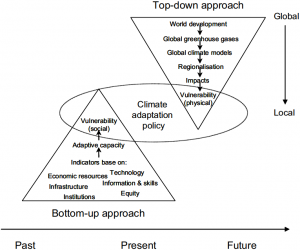The Ad Hoc Working Group on the Durban Platform for Enhanced Action (ADP) has two objectives taken on by two different workstreams. The goals of the ADP are to develop a new framework that will govern all parties under the UNFCCC by the COP 21 in 2015 and to close the ambition gap by ensuring the highest mitigation efforts by all parties. Keeping in mind the golden number, 2 degrees Celsius, is the limited amount of global temperature rise. The complexities of climate change involve multilevel governance. Finding the best approach towards climate governance is a heavily debated topic, given the difficulty of reaching a global agreement. Two opposing approaches are a top-down approach and a bottom-up approach. These approaches are used to link the economy and greenhouse gas emissions. Top-down involves a, “contractual approach favoring binding targets and timetables” (Bodansky, 1). While bottom-up involves, “facilitative approach favoring voluntary actions defined unilaterally”(Bodansky, 1). David Bodansky argues that an effective international agreement relies on multiple variables: stringency, participation, and compliance. However, “weakness along any of these three dimensions will undermine an agreement’s effectiveness” (Bodansky, 2). Which is why he argues both models should be merged in order to cumulate an effective agreement.
The Kyoto Protocol was expected to lead a long-term top-down approach for mitigating climate change. Developed and developing countries could not come to a consensus in the negotiation process. Instead, countries have taken on their own climate obligations through a bottom-up approach. The failure of the top-down approach through the Kyoto protocol allowed for alternative approaches to take way, such as the Cancun Agreements. At Cancun, “the Brazilian government declared it would halt all deforestation in Brazil by 2025” (King, 2011). A bottom-up approach essentially implements policies at the lowest level of organization. Thus, proposing the idea that action can be taken at every level. There are numerous municipal initiatives and cities that are the centers of innovation for more sustainable practices. While a top-down approach focuses its attention on mitigation, a bottom-up approach concentrates on adaptation and the notion of vulnerability. Local approaches tend to have more short-term results, whereas top-down methods involve long-term impacts.
A hybrid, or “mixed track,” approach will be necessary in order to establish absolute commitments. Both approaches have different strengths and weaknesses, but together the weaknesses are compensated. For example, bottom-up attracts participation and implementation but does not effectively enact regulations. On the other hand, top-down results show the opposite. Mitigation and adaptation are both equally important in combating climate change and can both be reached through a mixed track approach of governance. We must not only rely on global agreement and regulation, but also on local implementations and participation. A legally binding treaty would ensure compliance but in addition we need local projects and governance in order to take fast action. The combination of both top-down and bottom-up approaches will be the most effective route in achieving the post-2020 goals of the Ad Hoc Working Group on the Durban Platform on Enhanced Action.
Works cited
David Bodansky, “The Durban Platform: Issues and Options for a 2015 Agreement,” Center for Climate and Energy Solutions (2012): 1-11.
King, David, and Achim Steiner. “Is a Global Agreement the Only Way to Take Climate Change?” The Guardian. Guardian News and Media, n.d. Web. http://www.theguardian.com/commentisfree/2011/nov/27/durban-climate-change-delivery

